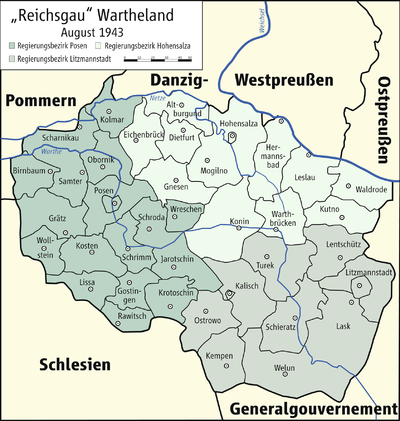Litzmannstadt district

Litzmannstadt district , from 1939 to 1940 Lodsch district , was the name of a German administrative unit in occupied Poland during the Second World War .
Prehistory (1793 to 1807)
The area around the cities of Łódź , Brzeziny and Zgierz belonged temporarily to the Brzezin and Zgierz districts in the Prussian province of South Prussia after the Second Partition of Poland from 1793 to 1807 .
Administrative history
At the beginning of the Second World War , German troops occupied the western Polish powiat Łódź , the district town of Łódź was taken on September 9, 1939.
On October 26, 1939, the powiat first became part of the Generalgouvernement .
On November 9, 1939, the powiat was annexed to the German Reich under the name Lodsch district (from April 11, 1940: Litzmannstadt district ) , which as a unilateral act of violence was ineffective under international law. The district became part of the Kalisch administrative district (from February 15, 1941: Litzmannstadt administrative district) in the Reichsgau Wartheland .
The seat of the German district office became the district town of Łódź , which did not belong to the district, but formed its own urban district .
On November 20, 1939, the district was enlarged to the east, the northwest third of the neighboring district Brzeziny was added together with the towns of Brzeziny and Stryków .
With effect from January 1, 1940, the districts of Brus, Chojny, Radogoszcz and Ruda Pabianicka were assigned to the extended urban district of Łódź and subordinated to the Lord Mayor, who dissolved them on April 1, 1940 and took over as districts.
The German occupation ended with the invasion of the Red Army in January 1945.
politics
Land Commissioner
- 1939 : Heinz Siepen
District administrators
- 1939–1941: Heinz Siepen
- 1941-1945: Herbert Mees
District leader of the NSDAP
- from January 30, 1940 (acting): Herbert Mees
Municipal structure
The localities in the Litzmannstadt district were initially grouped into 18, after the incorporation of April 1, 1940 in 14 districts. On April 1, 1942, three districts were named cities according to the German municipal code of 1935 ( Aleksandrów Łódzki , Konstantynów Łódzki and Zgierz ).
expansion
On November 9, 1939, the Lodsch district had an area of 942 km², after the expansion? km².
population
The district of Litzmannstadt had in 1941: 142,170 inhabitants (the urban district of the same name had 585,256 inhabitants).
The German occupation authorities expelled over 15,000 Poles from the area between December 1, 1939 and December 31, 1943 ( almost 33,000 Poles from the urban district ).
The Jewish citizens (about 25% of the population in the area, 230,000 of them in the city of Łódź in 1939 ) were initially concentrated in ghettos in Brzeziny , Stryków and Zgierz and then deported to the Łódź ghetto in 1942. Most of the ghetto population was murdered in the Auschwitz and Chełmno extermination camps until 1944 . After the end of the occupation, on June 15, 1945, 18,633 Jews were still counted in the city of Łódź.
Since the beginning of the 19th century, a German minority lived in the area with the centers Łódź (1939: 60,000 people or 9% of the city's population), Aleksandrów Łódzki (1921: 3,000 people or 37% of the city's population) and Nowosolna near Brzeziny (1921 : 1075 people or 95% of the urban population). (See also History of the Germans in the Łódź area .)
As a result of settlement, the German population in the district rose to 24% by 1942, and in the city of Łódź to 14% (95,000 people). After the occupation ended, most of the Germans left the area.
Place names
At the beginning of the occupation, some cities were given German place names, Łódź and Brzeziny , for example, were named after the Prussian general of the infantry a. D. Karl Litzmann , who distinguished himself during the First World War in the Łódź campaign and the breakthrough to Brzeziny (November 1914). On May 18, 1943, all places with a post or train station were given German names, mostly phonetic adjustments, translations or free inventions, in some cases the German place names of the native Germans were also adopted.
List of cities and administrative districts in the "Litzmannstadt district":
| Polish name | German name (1943–1945) | Polish name | German name (1943–1945) |
|---|---|---|---|
| Aleksandrów Łódzki | 1939–1943 Alexanderhof (Alexandrow) 1943–1945 Wirkheim |
Łódź |
1939–1940 Lodsch 1940–1945 Litzmannstadt |
| Bełdów | Beldow | Novosolna |
1939–1943 Neu Sulzfeld 1943–1945 Neusulzfeld |
| Brójce | Brojce | Radogoszcz |
1940–1943 Litzmannstadt-Radegast 1943–1945 Litzmannstadt-Waldborn |
| Brus | 1940–1945 Litzmannstadt-Bruss | Ruda Pabianicka | Litzmannstadt-Erzhausen |
| Brzeziny | 1940–1945 Lion City | Rzgów | Lancellenstatt |
| Chojny | 1940–1945 Litzmannstadt-Effingshausen 1943–1945 Litzmannstadt-Süd |
Stryków | Strickau |
| Gałków Duży | Galkau | Tuszyn | 1939–1945 Tuschin |
| Konstantynów Łódzki | Tuchingen | Zgierz | Gornau |
Web links
- Litzmannstadt district administrative history and the district administrators on the website territorial.de (Rolf Jehke), as of August 19, 2013.
- German Army Map (1944) of Łódź and the surrounding area
Individual evidence
- ^ Expansion of the boundaries of the Lodsch district. In: Lodscher Zeitung , February 4, 1940, page 11.
- ↑ [1]
- ↑ Lodsch on January 30th: Our home belongs to the Führer. The mass rally in the sports hall - a commitment to work and construction - establishment of the komm. District leader. In: Lodscher Zeitung January 31, 1940, pages 3-4.
- ↑ born November 29, 1910 in Pabianice , 1935–1939 Young German Party ( district leader Herbert Mees. A life of commitment - the acting district leader for the district of Lodsch. In: Lodscher Zeitung February 3, 1940, page 5)